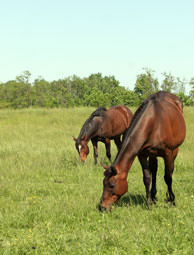
 Photo by Lesley Ward Slowly introduce horses to pasture in the spring to prevent the risk of colic and founder. |
As spring arrives, horse owners may be eager to save on hay and turn horses out onto the pasture. Before doing so, they need to consider if the pasture meets their horses’ nutrition requirements.
Pasture quality varies based on the plants there, such as grasses, legumes, weeds and shrubs. The nutrient quality, protein, energy and crude fiber values can vary significantly. In general, spring pasture quality will be different from the late growing season or winter pasture. Early spring grass is higher in protein and lower in carbohydrates (energy). This, coupled with the high water content of fresh grass, can cause diarrhea because the grass is more easily digested, so the rate of passage through the gastro-intestinal tract is faster.
![]() Slowly introducing your horses to spring pasture allows the bacteria responsible for digestion to adjust to the changes in the diet, allowing them to better digest the fresh forage. Pulling a horse off green pasture after an hour can be difficult—horses are reluctant to come in from that tasty grass—but you’re responsible for their management.
Slowly introducing your horses to spring pasture allows the bacteria responsible for digestion to adjust to the changes in the diet, allowing them to better digest the fresh forage. Pulling a horse off green pasture after an hour can be difficult—horses are reluctant to come in from that tasty grass—but you’re responsible for their management.
If you keep them on the pasture year-round and they start to search out grass as it grows, they will acclimate to the changes. If your horses have been kept on this pasture throughout winter, pulling them off and then putting them back on when everything is green will invite them to gorge themselves.
There is some risk of colic and founder when turning horses onto green pasture all at once. So if your horses are completely new to pasture, most veterinarians recommend turning them out for an hour the first day and extending their turnout time by an hour or so each day to gradually change them over. If you have insulin-resistant horses, gradual introduction is definitely recommended. Another solution is to put grazing muzzles on your horses so they won’t overeat and you won’t have to chase them around the pasture trying to convince them to give up the smorgasbord.
Whether you need to continue to supplement with hay depends on your pasture composition and your horses’ body condition. You can supplement their forage needs with hay, but you will probably notice that your horses will ignore the hay altogether if there’s pasture to be had.
In the summer when grass is growing tall, people can be fooled by what they see and assume the grass is full of nutrition, but tall, mature grass is actually low in protein, energy, vitamins and all the good stuff horses need (apart from fiber). Generally, more mature grass has more stem and less nutritional value.
Keep your pastures young by mowing or—better yet—using rotational grazing with mixed species. If you let forage plants grow too far toward maturity, palatability and, therefore, preference are reduced. Horses will chew some areas short and leave the tall stuff.
—Brian Nielsen, PhD, PAS, Dpl. ACAN, professor of equine exercise physiology at Michigan State University
This article originally appeared in the March/April issue of Hobby Farms.
About the Authors: Sharon Biggs Waller is an award-winning writer and author of Advanced English Riding (BowTie Press, 2007). She lives on a 10-acre hobby farm in northwest Indiana with her husband, Mark, 75 chickens, two Lamancha goats, two horses, and an assortment of cats and dogs. Dr. Lyle G. McNeal is a livestock specialist in the Department of Animal, Dairy and Veterinary Sciences at Utah State University.




